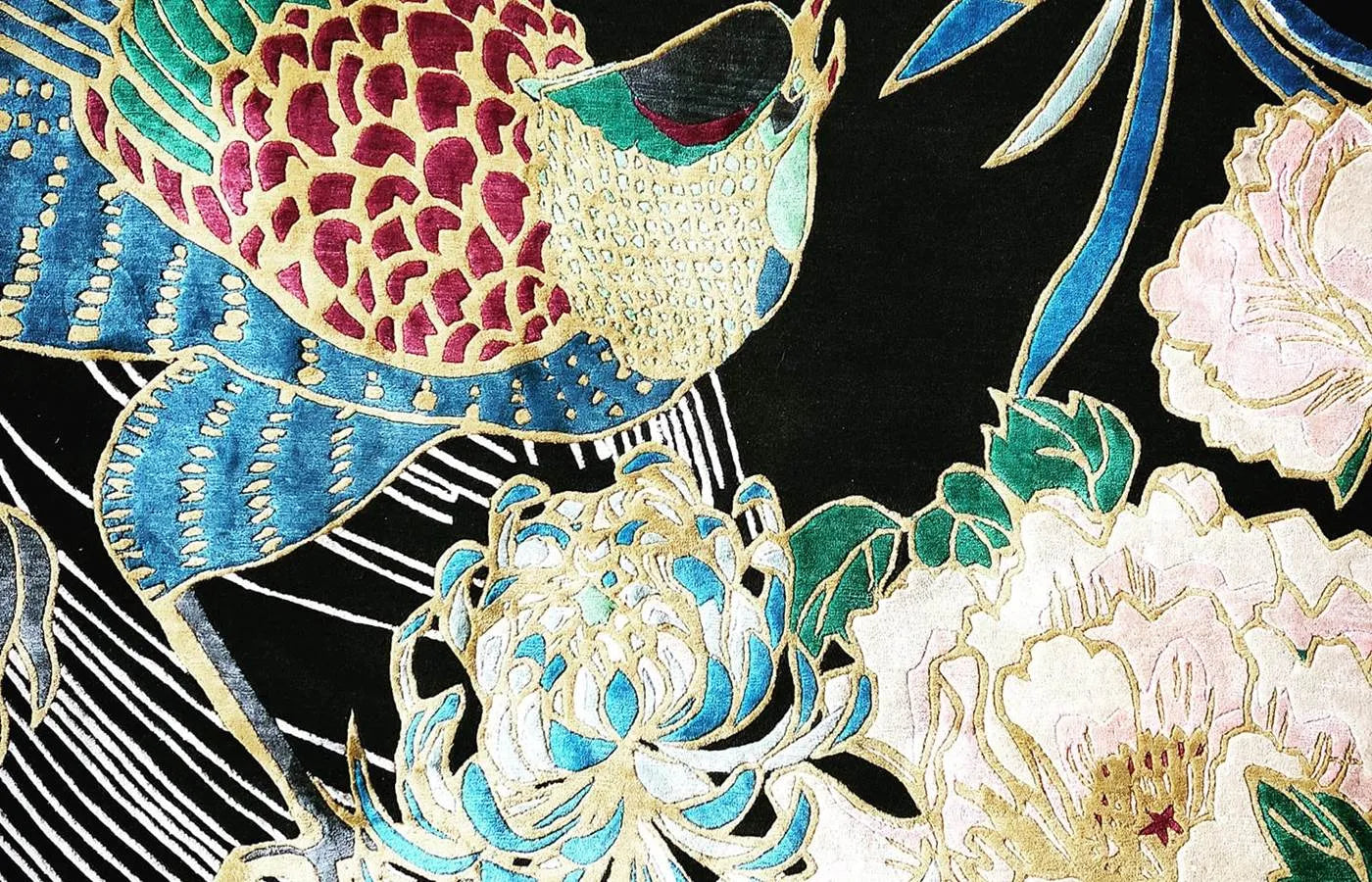We first introduced circular rugs into our collection four years ago with Okinawa and Okinawa Ocean and since then their popularity have sored. With a few more additions since then, plus many custom circular rugs.
Back in 2020 We’d been thinking about a circular rugs for a while, and were often asked for one. (On a more personal note, Wendy had long wanted a circular rug for her entrance hall, so there was an added incentive for her to create one!) Working within a circle presented fresh challenges, but it was a real pleasure to think and work in new ways, and we’re absolutely delighted with the results. (The entrance hall to Wendy’s home is looking pretty good too…)

Okinawa and Okinawa Ocean
Our original circular rugs, The hand-tufted Okinawa and Okinawa Ocean, which have a 100% wool base with vibrant details in Tencel, was initially inspired by a love of fine china, delicate vintage tea-sets and chinoiserie. As always, nature played its part with birds and florals, as well as a nod to Oriental symbolism, which is something we regularly return to for inspiration.

Saku
Saku, which means ‘to bloom’ in Japanese, also has a playful border, in the shape of a petal. Beautiful, life-affirming pink blossom, gold cranes and exotic birds are framed by the gorgeous, curved, petal-shaped outline of this rug. The connection with nature is reinforced by the motifs and the shape of this design, while a black frame grounds the many elements, making Saku a very easy rug to place.

One Hundred Flowers Circular
Adding an extra dimension, One Hundred Flowers features a stunning floral cut-out edge. Clusters of pink flowers etched in gold, green foliage and colourful birds form the outside edge. The combination of colour and the flower-shaped edging reinforces the idea of stepping into a beautiful garden.

Size and space
We thought it would be fun to share some tips on where, when and why you might choose a circular rug.
Some rooms are simply the wrong size or shape for a rectangular rug, but a circular rug opens up new possibilities. Suited to both contemporary and traditional schemes, circular rugs are perfect to highlight and show off rounded architectural details, such as a bay window, circular staircase or curved interior wall. Placing a round rug in an area that already has curves will draw attention to those details, creating a fabulous focal point.

Let’s go round again
Likewise, placing a circular rug underneath a round cupola, ceiling rose or light fitting highlights the feature, drawing the eye to it and giving the room a structured, well-designed feel. Teaming circular shapes together in this way creates maximum design impact.

Define your zone
Round rugs are particularly useful for creating ‘zones’ within a living space. Whether you are working with an open-plan interior or one room and want to define a particular space, a circular rug helps to visually separate areas.
Position an armchair, a small round table with a pile of books on the edge of a circular rug to create a natural reading area – regardless of the size of the room, the round rug helps to define the space. Using the same method, designate a chillout zone in a dining kitchen with a sofa positioned on the edge of a round rug. Or create a space for relaxation in a bedroom by teaming a chaise or daybed with a circular rug.

Heart of the home
Using a circular rug in a living area helps create a natural gathering space. Wendy found that her family would automatically be drawn to and gather round the circular rug when she used it in her lounge, with Eddie the lurcher happily settled in the middle.
Maximise your space
Using a large circular rug in a smaller room will actually make the room look bigger. The trick is to keep the front legs of any furniture on the edge of the rug. By doing this, the rug visually ‘connects’ the furniture and draws the eye across the room, making it appear bigger.
Create contrast
Round rugs add softer edges to a space and although they can be used to great effect in areas with curves, they also work well to create contrast against straight, sharp edges. As Wendy discovered, circular rugs work well in square entrance halls, drawing the eye away from the angles and corners, creating a warm and welcoming vibe.
Circular rugs are ideal to use as a focal point in a room. Team a beautiful round rug with a round dining table and pick up the accent colours from the rug to use in accessories throughout the room for a cohesive, designer look.
We love the playfulness and possibilities of our new circular rug – we hope you agree it’s a joyful addition to the Wendy Morrison family.


